Watermelon radish (or radish) – a hybrid crop named for its flesh's resemblance to the melon fruit. Its color ranges from pink to deep purple. The root vegetable's taste combines a spicy bitterness with pleasant sweetness. Its striking appearance, early maturity, and adaptability make it popular among gardeners.
In this article, we will discuss the cultivation techniques of watermelon radish, its health benefits, advantages, and drawbacks.
Table of contents
Hybrid Characteristics
Watermelon radish, more precisely a radish hybrid, belongs to the Brassicaceae family. European breeders developed this variety, and it quickly gained worldwide recognition. Depending on the growing region, there are European, Japanese, and Chinese varieties of watermelon radish.
In Europe, the crop appeared in the early 2000s, and in the EU and the US, it is now a staple in restaurant dishes.
Note. This crop was grown aboard the International Space Station to study genetic adaptations in microgravity.
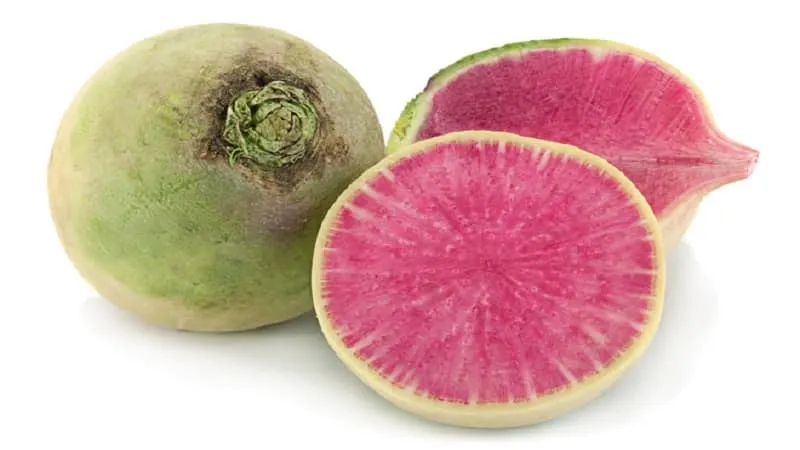
Fruit Description and Yield
The root vegetable comes in various shapes: oblong, spindle-like, or round. The flesh color varies from pale pink to vivid purple, while the skin remains white-green.
The diameter of the round variety, the most popular in Europe, is 8-9 cm.
The flesh is denser and drier compared to common radishes. The skin has a slightly bitter taste, while the core is sweet and pleasant. The intensity of bitterness depends on mustard oil content. As the radish matures, the sharpness mellows, but the contrast between sweet flesh and bitter skin remains.
Watermelon radish – a high-yield crop, cold-resistant, and can withstand brief frosts down to -5°C. With proper cultivation techniques, yields can reach several dozen tons per hectare. Productivity depends on seed size – larger seeds produce higher yields.
Health Benefits and Risks
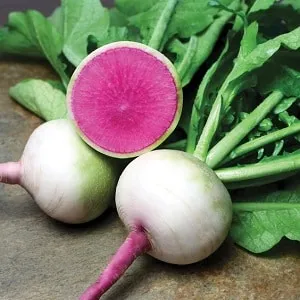 Watermelon radish contains:
Watermelon radish contains:
- Vitamins A, C, and B-group;
- Minerals: potassium, calcium, sodium, phosphorus, iron, magnesium;
- Nicotinic, salicylic, and folic acids;
- Glycosides;
- Mustard oil.
Its rich composition makes it highly beneficial for health. Regular consumption:
- Boosts immunity;
- Reduces fatigue;
- Enhances productivity;
- Improves digestion and appetite;
- Strengthens hair follicles;
- Enhances skin elasticity;
- Improves brain blood circulation.
Nutritional value per 100 g:
- Calories – 35 kcal;
- Protein – 2.5 g;
- Fats – 0.3 g;
- Carbohydrates – 2.9 g.
Low calorie content and high digestible protein make it ideal for weight-loss diets.
Important! Avoid consumption during stomach ulcer flare-ups or gastritis with high acidity, as it may irritate the stomach lining.
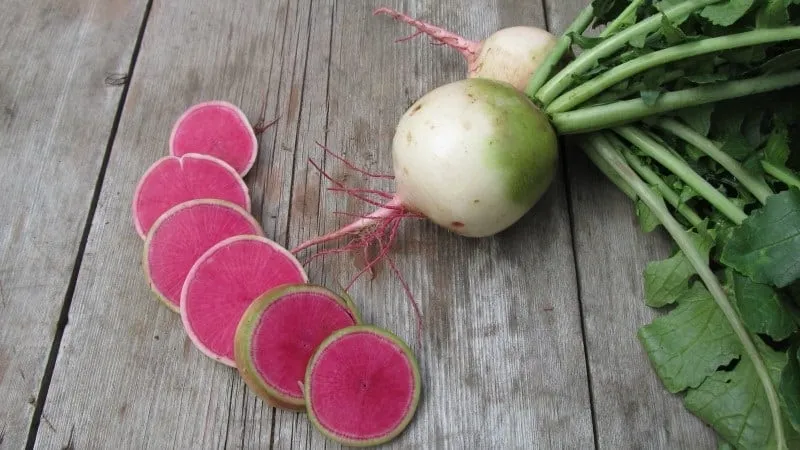
Cultivation Techniques
This crop belongs to the sowing radish group, so cultivation methods are similar. The short growing period (about a month) allows for 4-5 harvests per season.
Best results are achieved with July planting. Ideal conditions: average daily temperatures of +20-25°C and minimal rainfall.
Planting
Watermelon radish thrives in sandy loam and loamy soils with neutral pH (around 7). Acidic soil (pH below 7) is treated with dolomite flour, chalk, or lime, while alkaline soil (pH above 7) is amended with peat.
Hard, mineral-poor soil is unsuitable, as is overly fertilized soil. Radishes prefer loose, fertile ground. Before planting, till the soil in autumn (spade-depth) and fertilize with manure (4-5 kg per sq. m), superphosphate (13-20 g per sq. m), and potassium chloride (16-20 g per sq. m). In spring, loosen the soil and add ammonium nitrate (12-18 g per sq. m). Mulch with peat, hay, or straw.
Note. Best predecessors: cucumbers, tomatoes, potatoes, beans, and peas.
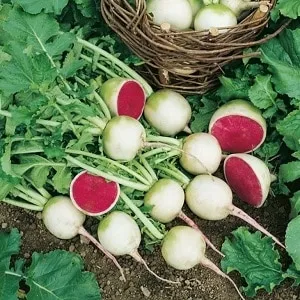 Sow seeds directly in soil warmed to +8°C. Timing depends on the region: in Southern Europe, planting starts in late April – early May; in Central Europe, two weeks later.
Sow seeds directly in soil warmed to +8°C. Timing depends on the region: in Southern Europe, planting starts in late April – early May; in Central Europe, two weeks later.
Soak seeds in cold water for 24 hours to speed up germination and ensure even root development.
Planting holes should be 3-4 cm deep. Add a pinch of superphosphate, cover lightly with soil, place seeds 2 cm deep, and water with settled water. Spacing: 40-50 cm – radishes need space. Seedlings emerge in 2-3 days.
Care
Proper watering is crucial. Drought causes bolting, slow growth, and woody texture. Overwatering leads to rot and fungal infections. Water moderately once a week; in heat, use sprinkling.
Loosen soil and weed every 3-4 days to aerate roots and accelerate growth.
Being an early crop, it dislikes excess fertilizer. Apply potassium-phosphorus supplements only once before sowing.
Diseases and Pests
Poor cultivation practices invite infections.
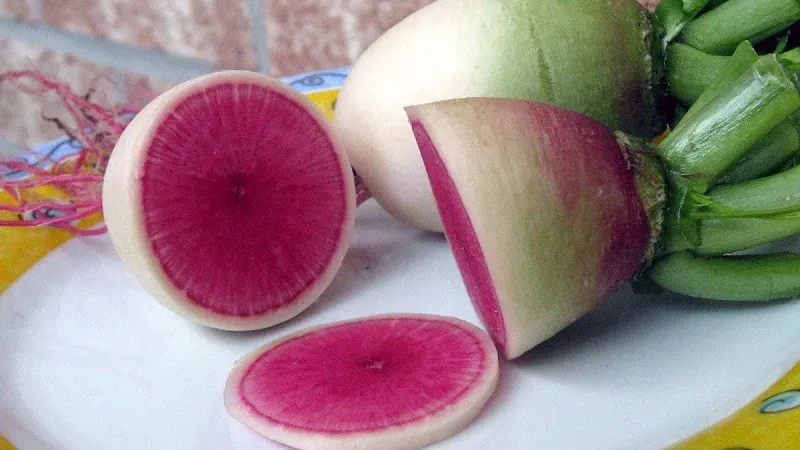
High soil acidity causes clubroot, a fungal disease. Spores spread via worms, deforming roots into hard, tumorous growths. No cure exists; prevent by liming soil and applying copper sulfate (50 g per sq. m).
Excess moisture, poor weeding, and crop rotation neglect lead to powdery mildew, gray mold, and white rust.
Powdery mildew appears as white coating, turning brown, drying leaves.
Gray mold shows as brown spots with gray fuzz.
White rust – oily white patches turning brown if untreated.
Treat fungal infections with copper sulfate, Bordeaux mixture, "Ridomil Gold MC," "Score," "Oxyhom," "Hom," "Fundazol," "Ditan M." Rotate products to prevent resistance. Add 50 g soap shavings for better adhesion.
Spring pests include cabbage fly and flea beetles, which devour foliage.
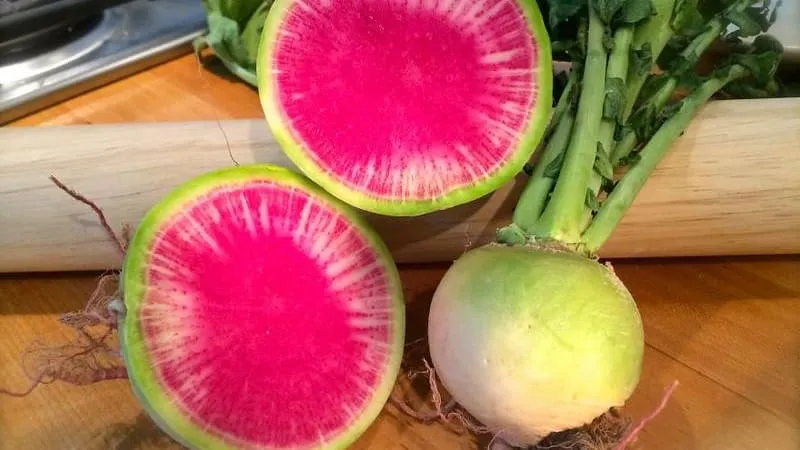
Pest control methods:
- Dust plants with a mix of tobacco, ash, naphthalene, and camphor (repeat weekly);
- Water with ammonia solution (5 ml per 10 L water);
- Apply saline solution (200 g per 10 L water) at the base;
- Spray with bay leaf infusion (10 g per 1 L boiling water);
- Dust with ash-road dust mix;
- Blend 200 g garlic shoots + tomato leaves, grind, mix with 10 L water + 20 ml liquid soap;
- Spray with vinegar solution (200 ml 9% vinegar per 10 L water);
- Use insecticides ("Sherpa," "Decis," "Actara," "Arrivo") in the evening.
Prevent infestations by covering crops with spunbond, agrofabric, or lutrasil, and follow proper cultivation.
Harvest and Usage
Harvest as radishes mature, in dry mornings/evenings, before frost.
Dry harvested radishes briefly outdoors. Store in a cool place: trim tops to 2 cm, inspect for damage, place in crates with ash/chalk.
Storage life: 2-3 months at 0 to +6°C.
Both roots and greens are edible. Add leaves to salads, soups, or cold dishes.
Roast, stew, boil, or use raw in salads and appetizers. Pairs well with meat, fish, and vegetables. Peel skin before use. Slice thinly, salt, and garnish dishes or drinks.
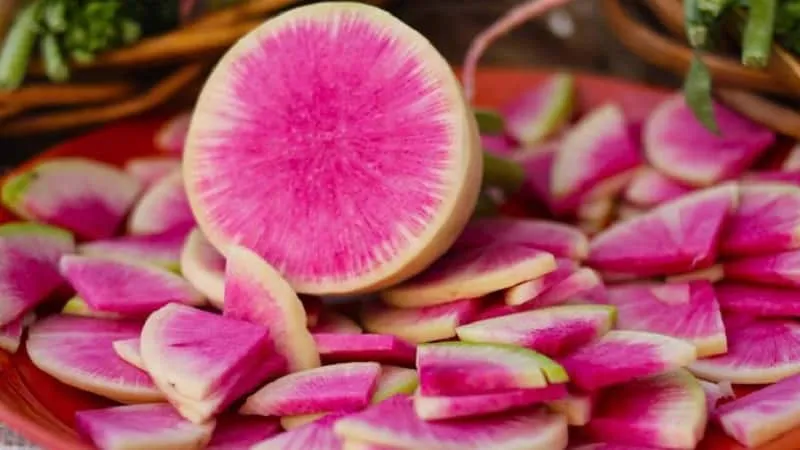
Watermelon Radish Salad with Cucumber and Carrot
Ingredients:
- 300 g watermelon radish;
- 300 g cucumbers;
- 200 g carrots;
- Dill bunch;
- 150 g 15% sour cream;
- Juice of ½ lemon;
- 1 tsp liquid honey;
- ½ tsp Dijon mustard;
- Sea salt, black pepper to taste.
Preparation:
- Wash, peel, and julienne vegetables (or use a mandoline).
- Chop dill finely.
- Mix sour cream, mustard, honey, lemon juice, salt, and pepper for dressing.
- Toss vegetables with dill, add dressing, and mix.
Growing in Protected and Open Ground
In Central Europe, sow in late March in greenhouses for April harvests.
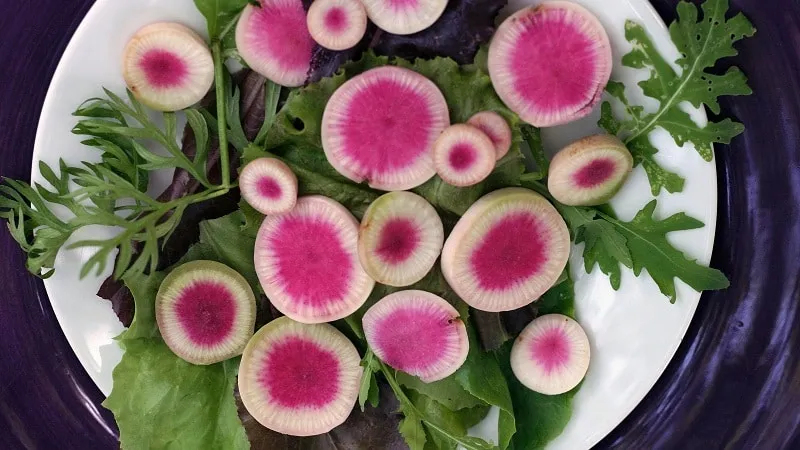
For open ground, plant in May for June harvests. Subsequent sowings in July and August.
Choose semi-shaded spots – excessive sun causes bolting and flowering, hindering root growth. Plant near shrubs or use shade cloth.
Pros and Cons
Advantages:
- Fast maturation;
- High yield;
- Good storage;
- Disease resistance;
- Pleasant taste;
- Vibrant flesh color.
Disadvantages:
- Soil, light, and water demands;
- Flavor loss if harvested late.
Testimonials
Watermelon radish is widely grown. Farmers note its manageable care, high yield, and enjoyable taste.
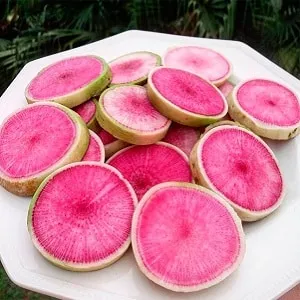 Sophie, Lyon, France: “I’ve grown watermelon radish for three summers. It thrives with frequent watering – drought makes roots too dry. I fertilize with compost and superphosphate in spring.”
Sophie, Lyon, France: “I’ve grown watermelon radish for three summers. It thrives with frequent watering – drought makes roots too dry. I fertilize with compost and superphosphate in spring.”
Klara, Berlin, Germany: “First tried it at a friend’s – loved the sweet-spicy contrast. Planted in my greenhouse in late spring. Harvested in a month. Consistent watering and weeding are key.”
Luca, Milan, Italy: “Discovered the seeds last year. Planted in July, spaced 50 cm apart, watered weekly, added potassium-phosphorus once. August harvest was a success!”
Conclusion
Watermelon radish demands specific soil, light, and moisture conditions. Proper techniques (loosening, weeding, watering), soil prep, and balanced fertilization ensure bountiful, flavorful yields.
While resistant to many diseases, fungi and pests (cabbage fly, flea beetles) can strike. Combat fungi with copper-based fungicides; deter pests with ash, vinegar, or insecticides like "Decis." Cover crops for prevention.







